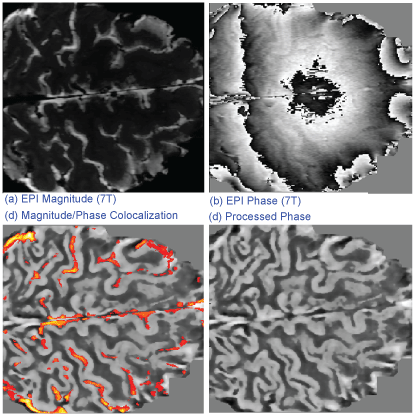A gradient-recalled echo (GRE) echo-planar imaging (EPI) sequence was used to acquire ultra high-resolution functional magnetic resonance imaging (fMRI) data from a healthy volunteer on a 7T Siemens MAGNETOM system. Data were acquired with the following sequence parameters: TR/TE = 3000/29 ms, voxel size: 0.45 × 0.45 × 1.2 mm3, image matrix = 234 × 234 × 24 (covering the superior portion of the brain, encompassing the primary motor cortex), no slice gap, 50 volumes. The output of the 7T GRE-EPI experiment produces a 4D complex dataset in matrix form.
Raw magnitude and phase images were extracted as shown in figure 1a and figure 1b, shown in an axial slice from a single volume acquisition. The raw brain phase image was severely phase-wrapped in figure 1b. The 3D phase image was subjected to 3D spatial phase unwrapping by a Laplacian technique [1] and other post processing (including homodyne high-pass filtering and nonlinear enhancement [2]). Ultra-high spatial resolution reveals detailed brain cortical sulci and gyri as shown in figure 1c. Because the images are derived from the same source, the magnitude and phase images are perfectly self-aligned. Figure 1d demonstrates an overlay of the magnitude image (thresholded for ridge extraction) and the phase image, which shows the spatial complement of the contrast contours in magnitude and phase images. Specifically, it is noted that a ridgeline in the magnitude image rides along a groove in the phase image. The high-field high-resolution fMRI reveals rich cortical details, especially the spatial complementary magnitude/phase image contrast, which may offer a new understanding of the MRI magnitude and phase signal mechanisms for brain functional mapping and neuroimaging [3].

Figure 1: (a) EPI Magnitude (7T); (b) EPI Phase; (c) Processed Phase; (d) Magnitude/Phase Colocalization.